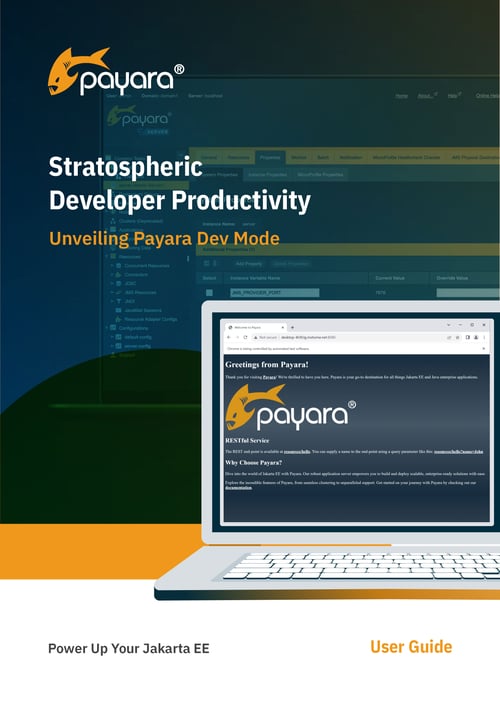Posts tagged Payara Platform (4)
What’s New In The August 2024 Payara Platform Release
Published on 14 Aug 2024
by Luqman Saeed
Topics:
Payara Platform,
New Releases,
Payara Enterprise,
Payara Community
|
0 Comments
We're pleased to announce the latest releases of Payara Platform, addressing key bug fixes and delivering component upgrades for improved performance and security. Thanks to these updates, users of Payara Platform Enterprise and/or Payara Platform Community, can benefit from a more reliable and optimized runtime environment.
What’s New In The July 2024 Payara Platform Release
Published on 17 Jul 2024
by Luqman Saeed
Topics:
Payara Platform
|
0 Comments
We're pleased to announce the latest releases of Payara Platform, bringing a range of updates across our Enterprise 5 and 6 editions as well as Community. These updates include bug fixes, performance optimizations, security enhancements and component upgrades to help you ensure your Jakarta EE and MicroProfile applications continue to run smoothly and effectively.
What’s New In The June 2024 Payara Platform Release
Published on 19 Jun 2024
by Luqman Saeed
Topics:
Payara Platform,
Payara Enterprise,
Payara Community
|
2 Comments
Freshly rejuvenated from the annual Payara Retreat, we're pleased to announce the latest releases of Payara Platform, bringing a range of updates across our Community and Enterprise editions. These updates include bug fixes, performance optimizations, security enhancements and component upgrades to ensure your Jakarta EE and MicroProfile applications continue to run smoothly.
Payara Server's High Availability Architecture: A Quick Technical Overview
Published on 05 Jun 2024
by Luqman Saeed
Topics:
JMS,
Hazelcast,
Payara Server,
Payara Platform,
Payara Enterprise,
Payara Community,
Jakarta EE
|
2 Comments
Introduction
In today's business world, competition is fierce and relentless. As a result, maximizing uptime while reducing downtime and its expenses is a top priority. In particular, users now expect applications to deliver consistent performance, regardless of unexpected challenges. Payara Server offers a high availability (HA) architecture that is designed to keep your business operational at all times. This blog post explores the components and configurations needed to create a highly available Payara Server environment, ensuring your applications remain accessible and responsive.
Announcing Payara’s First Jakarta EE Media and Community Challenge
Published on 27 May 2024
by Chiara Civardi
Topics:
news and events,
Payara Platform,
Java,
Jakarta EE
|
0 Comments
We have exciting news to share: As part of our Power Up Your Jakarta EE campaign, we are launching Payara's first-ever Jakarta EE Media and Community Challenge!
We’re calling on Java experts, tech writers and content creators from around the world to showcase their talent by developing insightful content focused on Jakarta EE and the Payara Platform application server. This initiative is designed to inspire innovation and foster knowledge-sharing within the Java community.
What’s New In The May 2024 Payara Platform Release
Published on 08 May 2024
by Luqman Saeed
Topics:
Payara Platform
|
0 Comments
Microservices Mania: Are Moduliths the Saner Path to Scalable Architectures?
Published on 02 May 2024
by Luqman Saeed
Topics:
Microservices,
Payara Platform,
Jakarta EE
|
0 Comments
Introduction
Lately, microservices have become extremely popular in software design. They offer the ability to scale, deploy updates independently and use different technologies. However, it's easy to forget how complex microservices can be to manage. Inspired in part by the introduction of Spring Modulith, a top-level Spring project aimed at helping developers create evolvable applications, this blog post takes a fresh look at the concept of modularity.
Stratospheric Developer Productivity - Unveiling Payara Dev Mode
Published on 19 Apr 2024
by Chiara Civardi
Topics:
Maven,
Payara Micro,
DevOps,
Payara Platform,
Java,
Jakarta EE
|
0 Comments
Development productivity is crucial in Enterprise Java and Jakarta EE application development, supporting the delivery of high-quality software solutions quickly and efficiently. As a result, it is necessary to focus on streamlining development processes, optimizing resource utilization and empowering developers to work more effectively. Payara Micro Maven Plugin, Version 1, introduces a powerful tool – Dev Mode – designed to supercharge your development experience with Payara Micro.
In our latest User Guide - available to download here - we look at this plugin, exploring its features, configurations and usage to help developers unlock stratospheric levels of productivity.
What’s New In The April 2024 Payara Platform Release
Published on 10 Apr 2024
by Luqman Saeed
Topics:
Payara Platform,
New Releases
|
0 Comments
We're excited to announce the April 2024 release of Payara Platform! This update includes a mix of critical bug fixes, component upgrades, and exciting new tools in the Payara Tooling Ecosystem. Our enterprise customers will particularly benefit from the new Diagnostics Tool and Dependabot scanner, designed to streamline operations and security. Also, everyone gets a glimpse into the future with the Payara 7 Alpha 1 preview!
A Quick Guide To Dynamic Queries with Jakarta Persistence
Published on 28 Mar 2024
by Chiara Civardi
Topics:
Payara Platform,
Java,
Jakarta EE,
jakarta persistence criteria api
|
0 Comments
To effectively express a query, it's important to utilize a typesafe way that help you enhance readability and reduce runtime errors.
Our latest User Guide - available to download here - discusses how to use the Jakarta Persistence API (JPA) Criteria API to build dynamic entity queries programmatically.






